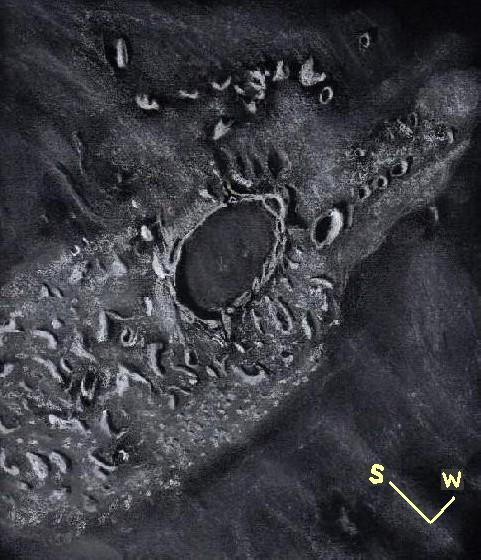Plato and Environs
Sketch and Details by Frank McCabe
One of the more famous features of the lunar surface is the walled plain crater Plato. This 100 kilometer crater was formed on the blocks of ejecta or the debris field (lunar Alps) of the Mare Imbrian basin forming event and it preceded the lava upwelling that flooded the floor of the crater and then the maria. Beyond the highland rise of the crater to the north is Mare Frigoris. To the west of the crater is Plato A a 22 km. crater beyond the ramparts of Plato. Just on to the smooth Imbrian lava to the south are the Teneriffe Mountains including Mount Pico at the east end of the chain. A portion of Rimae Plato was visible intermittently in among the rugged mountain bases of the Alps as seeing briefly reached average value now and again. The central peaks present at the time of the Plato impact are buried under 2 kilometer of lava and only small craterlets can be seen on the floor. Two of these were in and out of visibility as I drew this sketch. The rim on the shadowed side of the crater has irregular peaks that reach to 2.6 km. above the crater floor. At times of lower sun angles the irregular peaks cast long shadows that allow you to locate these summits.
In the years of the 17th century after the invention of the telescope, crater Plato changed names three times. In 1645 it was named Lacus Panciroli by Michael van Langren and in 1647 Johannes Hevelius named it Lacus Niger Major and finally Fr. John Baptist Riccioli in 1651 gave it the name we call it to this day.
If you have a telescope take a look at the crater floor and watch it change in brightness as we approach and then go past full moon. The moon is not light pollution it is a rewarding astronomical target.
Sketching:
For this sketch I used: black Strathmore 400 Artagain paper 10”x12”, white and black Conte’ pastel pencils and a blending stump. After scanning, Brightness was decreased (-2) and contrast increased (+2) using Microsoft Office Picture Manager.
Telescope: 10 inch f/ 5.7 Dobsonian and 9 mm eyepiece 161x
Date: 9-10-2008, 1:15 – 2:30 UT
Temperature: 15° C (60° F)
clear, calm
Seeing: Antoniadi III
Colongitude 29.6 °
Lunation 10.2 days
Illumination 72.7 %
Frank McCabe


Very good work there Frank of a very tough region to capture well.
Dale
Dale,
Thank you, every sketch is a real learning experience for me. I sacrificed some accuracy with this one as I rushed to finish.
Frank
Frank,
I find it amazing that you are able to capture the lifeless and starkness of the Lunar terrain with such passion and skill as to make it appear alive with a personality all its own.
It is sketches such as these that have enticed me to become interested in observing the Lunar landscape through my own EP.
Very nicely done!
WadeVC
Wade,
Thank you very much. The moon is a wonderful target, endlessly changing.
Frank